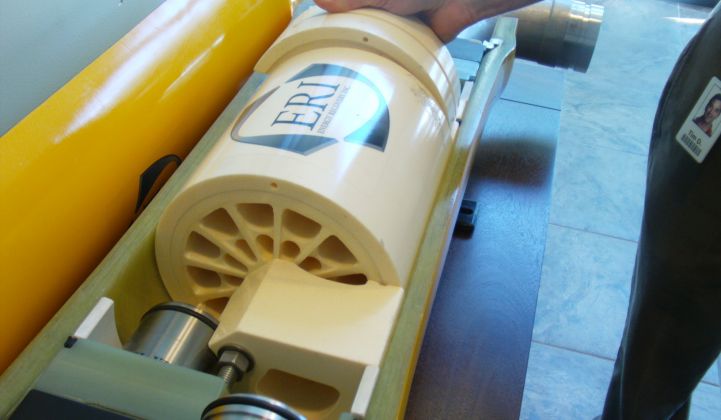Energy Recovery has won a contract to supply its Pressure Exchanger desalination systems to a large plant being erected by Befesa in Qingdao, China.
The plant will generate 100,000 cubic meters, or 26.4 million gallons, of water each day and serve over 500,000 consumers through reverse osmosis. It is the seventh time the two companies have worked together on a plant.
Reverse osmosis desalination generally is energy-intensive: water needs to get highly pressurized before a reverse osmosis membrane can extract the salt and other impurities. Energy Recovery reduces the amount of energy required in desalination by harnessing the waste stream from the reverse osmosis process (only about 60 percent of water is purified; the remaining 40 percent just becomes saltier seawater) to pre-pressurize incoming sea water. The wastewater effectively collides with incoming seawater contained in ceramic chambers: nearly 98 percent of the pressure in the waste stream gets transferred to the incoming sea water, in much the same way that the energy from a cue ball might get transferred to an eight ball. (Shown is a picture of the inside of one of the company's pressure exchangers.)
Desalinated sea water is a last-resort source of water. As in energy, larger, cheaper gains could be made through efficiency and conservation. Unfortunately, water is also highly subsidized, so getting farmers and consumers to care about their bills can be challenging. Municipal water agencies are also chronically sclerotic: utilities look like loosey-goosey Web 2.0 outfits in comparison. Nonetheless, demand for desalination technologies continues to grow. Marin County will vote on two competing desalination measures in November.
Elsewhere:
--Autodesk has launched an effort for Granta Design to make it easier for manufacturers to build products out of sustainable and recyclable materials. How? Autodesk will incorporate Granta's materials databases into its prototyping software and other products. That way, engineers and designers can contemplate using recyclable materials at the very start of the design process.
"Eighty percent of the products's environmental footprint is determined in the early stages of design," said Sarah Krasley, the industry manager of sustainability at Autodesk. Variables like shape, packaging, fabrics, plastics, etc., are all determined in that early stage. "Recyclability is now top-of-mind" among corporate engineering departments, she added.
Some novel ideas out there: Steelcase has discussed employing certain species of hardy mushrooms to replace foam packing. Several automakers want to swap out steel and metal for lightweight polymers. Some companies are also looking at ways to utilize 3D printing -- currently employed by major manufacturers to print three-dimensional components for lab prototypes -- for ad hoc manufacturing. Instead of producing a line of replacement parts for dishwashers, a company could just send customers a program that would allow them to print a new part at their local branch of Kinko's, or some other place with an industrial 3D printer. The manufacturing efficiencies, combined with reductions in transportation and storage, could be tremendous.
--One anticipates a lot of jumping up and down and merriment this week at Achates Power, EcoMotors and Nanostellar. The three are some of the very few green diesel technology startups. (Achates and EcoMotors have developed efficient diesel and gas engines, while Nanostellar has a catalytic powders for diesel engines). The Department of Transportation proposed new standards for trucks, vans and buses yesterday that will raise efficiency by 10 percent to 20 percent by 2018, depending on the class of vehicles and whether they run on diesel or gas. Oorja Protonics, which makes a methanol fuel cell, hopes to benefit from diesel fever with a fuel cell for running the living quarters in big rigs. (Firefly Energy hoped to make batteries for this same application but became road kill in March.)
The improved energy consumption could pay for the additional costs in some circumstances within a year, the DOT claimed, and save a big rig driver $74,000 over the life of a rig. (Somebody call C.W. McCall.) California imposed its own diesel regulations in 2008 that go into effect in 2011.
The DOT's regulations aren't in force yet. Now comes the comment period. While the proposed regulations apply to vocational vehicles, rising gas prices, high performance, more pumps and other factors have also improved the market for diesel car makers in recent years. Last year, both Audi and Volkswagon sold more diesels in the U.S. than expected.



